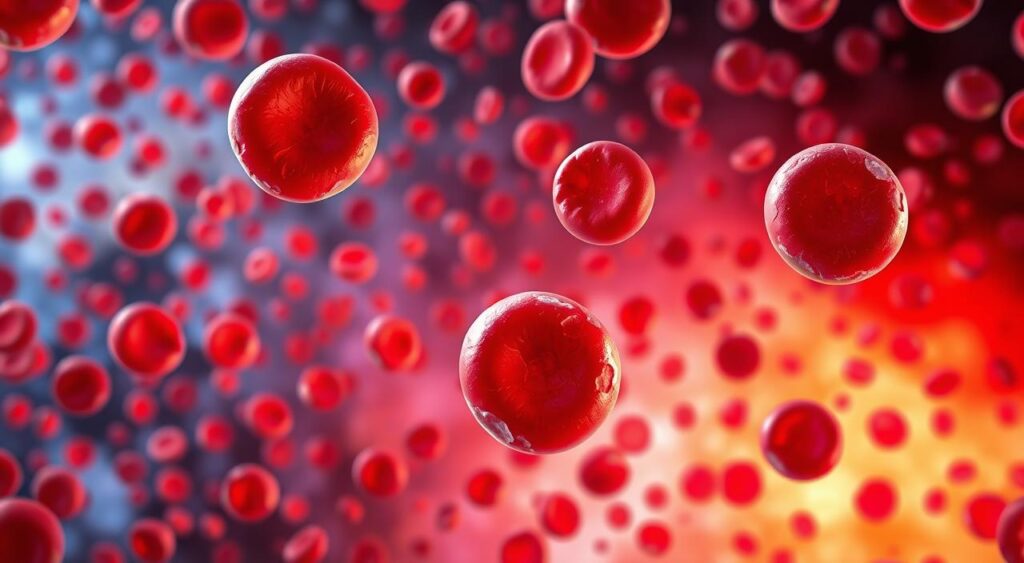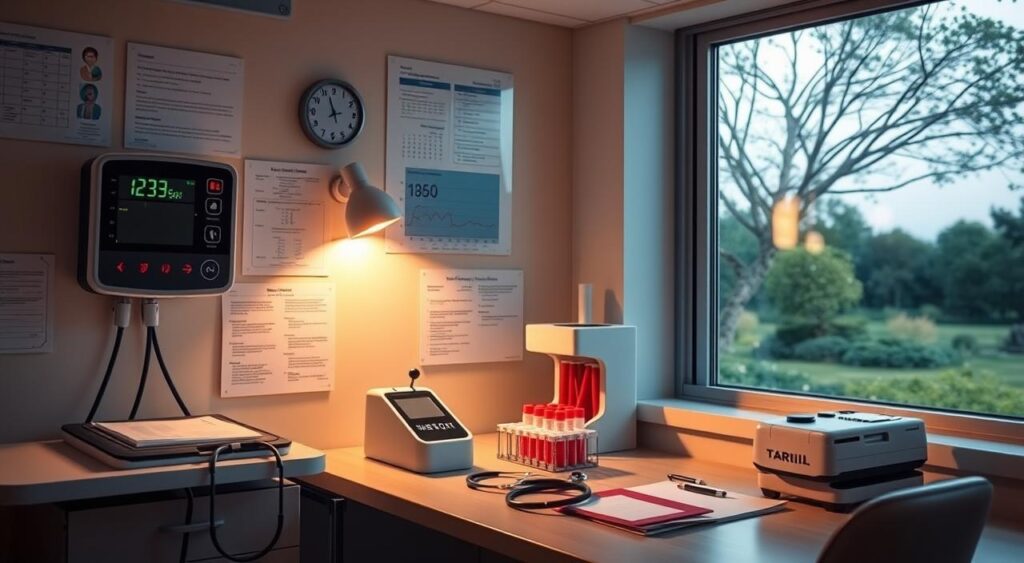Polycythemia vera, or pv, is a rare blood disorder. It causes too many red blood cells to be made. This can lead to serious problems if not treated right.
Knowing about pv is key for those with it. It’s a myeloproliferative disorder that needs close watch and treatment to avoid risks.

Dealing with pv means knowing the symptoms, how it’s diagnosed, and how to manage it. Understanding pv helps people face its challenges better.
Key Takeaways
- Polycythemia vera is a rare blood disorder characterized by excessive red blood cell production.
- PV is a type of myeloproliferative disorder that requires careful management.
- Understanding symptoms, diagnosis, and treatment options is crucial for individuals with polycythemia vera.
- Regular monitoring and follow-up care are essential for managing pv and preventing complications.
- Lifestyle modifications and self-care strategies can help individuals with polycythemia vera manage their condition.
- Staying informed about the latest research and treatment options can help individuals with pv make informed decisions about their care.
Understanding Polycythemia Vera
Polycythemia Vera is a disorder where the bone marrow makes too many red blood cells. This can cause blood clots and heart problems. Finding out why this happens is key to managing it.
The JAK2 mutation often causes Polycythemia Vera. This genetic change makes too many red blood cells. Knowing about the JAK2 mutation helps doctors find better treatments.
What is Polycythemia Vera?
Polycythemia Vera is a type of blood disorder. It makes too many blood cells, which can lead to clots and heart issues. Symptoms include headaches, dizziness, and tiredness.
Causes and Risk Factors
We don’t know all the reasons for Polycythemia Vera, but the JAK2 mutation is a big one. Family history, age, and toxins might also play a part. Knowing these can help manage the condition.
The Role of JAK2 Mutation
The JAK2 mutation is crucial in Polycythemia Vera. It changes the JAK2 gene, which controls red blood cell production. This can cause too many red blood cells, leading to clots and heart issues.
Common Signs and Symptoms
Polycythemia symptoms can differ from person to person. Common signs include headaches, dizziness, and itching. These symptoms can be mild or severe and affect many areas of health and life quality.
Some people feel fatigue, which can make daily tasks hard. Others might see redness or flushing on their face and hands.
- Headaches
- Dizziness
- Itching
- Fatigue
- Redness or flushing of the skin
It’s important to recognize these symptoms early. This helps in getting medical help sooner. Knowing the common signs and symptoms is the first step to managing the condition and improving health.
Complications Associated with Polycythemia Vera
Polycythemia Vera can cause several problems, mainly because of the blood’s thickening from too many red blood cells. This makes it more likely for blood clotting and heart diseases to happen. These are common issues linked to this blood disorder.
Some of the possible problems include:
- Blood clotting risks: The thick blood can form dangerous clots. These can be deadly if not treated quickly.
- Cardiovascular complications: The danger of blood clots also raises the risk of heart attacks and strokes.
- Progression to other blood disorders: Sometimes, Polycythemia Vera can turn into other blood disorders, like myelofibrosis or acute myeloid leukemia.
It’s crucial to manage Polycythemia Vera well to avoid these risks and complications. Regular check-ups and care can spot problems early. This allows for quick treatment and better outcomes for those with this blood disorder.
| Complication | Description |
|---|---|
| Blood Clotting Risks | Increased viscosity of blood can lead to the formation of blood clots. |
| Cardiovascular Complications | Increased risk of blood clots can lead to cardiovascular diseases, such as heart attacks and strokes. |
| Progression to Other Blood Disorders | Polycythemia Vera can progress to other blood disorders, such as myelofibrosis or acute myeloid leukemia. |
Diagnostic Process and Testing
The polycythemia diagnosis process includes a physical exam, medical history, and specific tests. Blood tests like complete blood counts and blood smears check the patient’s condition. Sometimes, a bone marrow biopsy is needed to confirm the diagnosis.
A polycythemia diagnosis is made from these test results. They show the disease’s key features. Here are some important tests:
- Complete blood counts to evaluate the patient’s blood cell counts
- Blood smears to examine the shape and size of blood cells
- Genetic tests to identify the JAK2 mutation
Knowing about the diagnostic process is key for patients with polycythemia vera symptoms. Working with their healthcare provider helps get an accurate polycythemia diagnosis. This leads to a good treatment plan.
| Test | Description |
|---|---|
| Complete Blood Counts | Evaluate blood cell counts |
| Blood Smears | Examine shape and size of blood cells |
| Genetic Tests | Identify JAK2 mutation |
Treatment Options for Polycythemia Vera
Polycythemia treatment aims to lower the risk of complications and ease symptoms. The main goal is to cut down on blood clots and other issues linked to polycythemia vera. A key method is to lower the number of red blood cells.
Phlebotomy is a common polycythemia treatment to reduce red blood cells. It involves taking blood out of the body to lower red blood cell levels. This helps to lessen the chance of blood clots and other problems.
Medications and Therapies
Along with phlebotomy, medicines and therapies are used in polycythemia treatment. These include drugs like hydroxyurea to slow blood cell production, or interferon alpha. The right medicine depends on the person’s needs and how severe their condition is.
Emerging Treatments
Scientists are always looking for new polycythemia treatment options. New treatments, like JAK inhibitors, give hope to those with polycythemia vera. These treatments target specific genetic changes, offering a more focused way to manage the condition.
It’s crucial to work with a healthcare provider to find the best polycythemia treatment for each person. Knowing the different treatment options helps patients make informed choices about their care. This way, they can actively manage their condition.
Living with Polycythemia Vera
Living with polycythemia vera means understanding how to manage it well. People with this condition can change their lifestyle to lower risks. This includes eating right, exercising, and managing stress. These changes can help avoid complications and improve life quality.
Some important things to consider when living with polycythemia vera include:
- Staying hydrated by drinking plenty of water
- Avoiding heavy lifting or strenuous activities that may increase the risk of blood clots
- Quitting smoking and avoiding secondhand smoke
- Maintaining a healthy weight through a balanced diet and regular exercise
Also, working closely with a healthcare provider is key. They will monitor the condition and adjust treatments as needed. This may include blood tests, medications, and other therapies. By being proactive and making smart lifestyle choices, people can manage their condition well.

By focusing on health and making smart choices, people with polycythemia vera can live full lives. It’s crucial to stay informed about the condition and its management. This ensures the best outcomes for those living with polycythemia vera.
Lifestyle Modifications and Self-Care
People with polycythemia vera can manage their condition better with lifestyle changes. Eating well and exercising regularly are key for health. These changes can lower the risk of problems and make life better.
Some important lifestyle changes for polycythemia vera include:
- Dietary changes: A balanced diet, low in saturated fats and high in fruits and veggies, can lower blood clot risks.
- Regular exercise: Activities like walking or swimming can improve blood flow and reduce clot risks.
- Stress management: Stress-reducing activities, like meditation or deep breathing, can help manage stress and anxiety.
By adopting these lifestyle changes, individuals can actively manage their condition and enhance their health. It’s crucial to work with a healthcare provider to create a personalized plan. This plan should fit individual needs and health status.
Monitoring and Follow-up Care
Regular monitoring is key for adjusting treatment and getting the best results for those with polycythemia vera. Monitoring polycythemia vera means doing tests and check-ups to see how the condition is doing. This care is vital for managing the condition well and avoiding problems.
Important parts of monitoring and follow-up care include:
- Regular blood tests to check blood cell counts and adjust treatment if needed
- Handling side effects of treatments, like itching or feeling tired
- Regular visits with a healthcare provider to talk about any concerns or changes in symptoms
By focusing on monitoring and follow-up care, people with polycythemia vera can work with their healthcare provider. This helps manage their condition and improve their life quality.

Regular Blood Tests
Regular blood tests are a key part of watching polycythemia vera. These tests help doctors see changes in blood cell counts. They then adjust treatment as needed.
Managing Side Effects
Handling side effects of treatments is also crucial in monitoring and follow-up care. By working with a healthcare provider, people with polycythemia vera can lessen side effects. This improves their overall health and well-being.
Support Resources and Patient Communities
Living with a rare blood disorder like Polycythemia Vera is tough, both physically and emotionally. Support for polycythemia vera patients is key to managing the condition. Patient communities and support groups offer valuable resources. They provide a space for people to share their stories and learn from others facing similar challenges.
Being part of a patient community has many benefits:
- Connecting with others who understand the challenges of living with Polycythemia Vera
- Gaining access to valuable resources and information
- Sharing experiences and advice with others
These communities provide support for polycythemia vera patients, making them feel less alone. They offer online forums, support groups, and educational resources. These help individuals connect with others and find the help they need.
Joining a patient community can be a powerful way to take control of your health and well-being, and to find the support and connection you need to thrive.
Conclusion: Managing Your Journey with Polycythemia Vera
To effectively manage polycythemia vera, you need to understand the condition well. It’s important to know its symptoms, get the right diagnosis and treatment, and make lifestyle changes. Also, seeking support is crucial.
By staying informed and working with your healthcare team, you can manage your condition better. Making lifestyle adjustments helps too. Remember, with the right care and self-management, you can live well with polycythemia vera.
FAQ
What is Polycythemia Vera?
Polycythemia Vera (PV) is a rare disorder where the bone marrow makes too many red blood cells. This makes the blood thick and hard to flow.
What are the causes and risk factors of Polycythemia Vera?
A mutation in the JAK2 gene causes PV. This gene helps control how blood cells are made. Age, gender, and family history can also increase your risk.
What are the common symptoms of Polycythemia Vera?
Symptoms include headaches, dizziness, and feeling tired. You might also itch after a warm bath or shower. The face may look red, and you might feel full in your stomach. Blood clots are also a risk.
What are the potential complications associated with Polycythemia Vera?
PV can cause blood clots and heart problems like heart attacks or strokes. It can also turn into other blood disorders, like myelofibrosis or leukemia.
How is Polycythemia Vera diagnosed?
Doctors use physical exams, medical history, and lab tests to diagnose PV. Tests include blood counts, blood smears, and genetic tests for the JAK2 mutation. Sometimes, a bone marrow biopsy is needed.
What are the treatment options for Polycythemia Vera?
Treatment for PV includes removing excess red blood cells through phlebotomy. Medications like hydroxyurea or JAK inhibitors can also help. In some cases, more advanced treatments or stem cell transplants are considered.
How can individuals with Polycythemia Vera manage their condition effectively?
Effective management includes following your treatment plan, eating well, exercising, and managing stress. Regular check-ups with your doctor are also key.
What support resources are available for individuals with Polycythemia Vera?
There are many resources for PV patients, like patient groups, online forums, and support groups. They offer information, emotional support, and a chance to connect with others.
